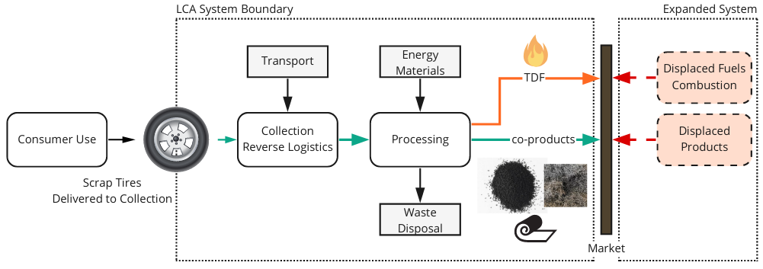CATRA Members Gain Value From Life Cycle Analysis Project
CATRA Members Gain Value From Life Cycle Analysis Project
Across Canada, tire recycling agencies ensure that scrap tires go on to have a second life as a marketable tire derived product (TDP). In virtually every case, TDPs displace the more conventional use of ‘new’ material. A simple example is producing rubber mats from recycled tire rubber, displacing the use of new synthetic rubber.
People expect that products made from recycled tires will deliver ecological benefits when compared to the use of the materials they displace. Putting numbers to this expectation was at the heart of a Life Cycle Analysis (LCA) project that was a collective effort of 7 of CATRA’s 9 provincial member organizations. The effort saw the collection and analysis of three years of data from each organization and, in Spring 2022, each participant received an individual provincial LCA report. As well, an aggregate report was provided that essentially represents 96% of all scrap tires collected and processed in Canada. The engagement of a critical review panel has ensured that the methodology of analysis and reporting meets international standards (ISO 14044).
Study Overview
The LCA study looks through a lens of several environmental indicators that include GHGs, smog, particulates, acidification, ozone depletion, and eutrophication. Results show how a TDP fares, in each of these categories, when compared to the life cycle impacts of its respective displaced material. Results also show how TDPs compare with each other when it comes to ecological impacts.
The work by California-based Scope 3 Consulting established a boundary for analysis around the scrap tire management system that begins when used tires are first returned to a collection site. The impacts of transporting the tires and processing them into TDPs are compared to the impacts of producing conventional non-tire-derived products. Widely accepted industry data sources were employed for the task of assigning quantitative ecological impacts for the life cycle of each TDP and its respective displaced product. , these impacts are calculated to the point at which the material is ready for delivery to its end-use.
While there is a range in the extent to which different TDPs deliver ecological benefits, it stands that Canadians clearly benefit from recycling scrap tires into the TDPs that are currently produced with the support of scrap tire management agencies.
Other more specific findings are:
· Environmental impacts from collection and reverse logistics are small compared to impacts from scrap tire processing
· The best-performing routes include replacing primary rubber, retread, and blast mats
· Rubber-modified asphalt (RMA) is beneficial if roadway service lifetime is extended
Results Inform Program Decisions
With this newly verified knowledge, participating provinces have an additional resource that allows them to consider ecological impacts along with many other factors that go into planning and decision-making for their regional programs. This in turn enables the participants, each having their own specific operational basis with mandated goals and targets, to define or re-define their definition of success. They can now show the numbers that support their claims of ecological responsibility and, in some cases, justify new directions and investments.
Public Report
In response to outside interest, the LCA Report has been modified to provide a version that can be shared with the public. This public report helps CATRA tell a good news story about tire recycling in Canada while ensuring that confidential details are not shared.
More information, specific to their case, is available from some participating provinces:
Ontario: eTracks Tire Management System - Tire Recycling Avoids Harmful Emissions, 2019 – 2023 Ontario Data
Manitoba: Tire Stewardship Manitoba –Studies and Reports / Full report
